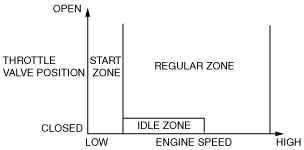|
Correction
|
Engine coolant temperature spark advance correction
|
Purpose: Protects combustion stability when engine coolant temperature is low.
Except during idling
• High charging efficiency*1, low engine coolant temperature→large correction
|
|
×
|
×
|
|
Warm-up promotion spark retard correction
|
Purpose: Activates the catalytic converter earlier
Constant period after engine start
• According to engine coolant temperature→correction
|
|
×
|
|
|
Feedback correction
|
Purpose: Ensures idling stability
During idling (inhibited during test mode)
• Large difference between actual engine speed and target engine speed→large correction
• Small difference between actual engine speed and target engine speed→small correction
|
|
×
|
|
|
Correction
|
Variable tumble spark advance correction
|
Purpose: ignition timing optimization during variable tumble control
Controls spark advance amount according to the variable tumble shutter valve open/closed condition
• Closed condition→small spark advance amount
• Open condition→large spark advance amount
|
|
|
×
|
|
Shift spark retard correction (ATX)
|
Purpose: Reduces shift shock during shifting
Determined according to torque reduction request signal from the ATX control
• Large torque down request during shifting→large correction
|
|
|
×
|
|
Deceleration fuel cut recovery retard correction
|
Purpose: Reduces shock after recovery from deceleration fuel cut and during re-acceleration while in deceleration fuel cut
Re-acceleration after recovery from deceleration fuel cut and while in deceleration fuel cut
• Low engine coolant temperature→large correction
|
|
×
|
×
|
|
Acceleration spark retard correction
|
Purpose: Prevents knocking and shock during sudden acceleration
Acceleration when charging efficiency*1volume increase (acceleration amount) is constant value or more.
• High acceleration amount→high retard
|
|
|
×
|
|
Knocking spark retard correction
|
Purpose: Knocking suppression
When knocking is detected while driving under high load
• Large amount of knocking→large correction
|
|
|
×
|



